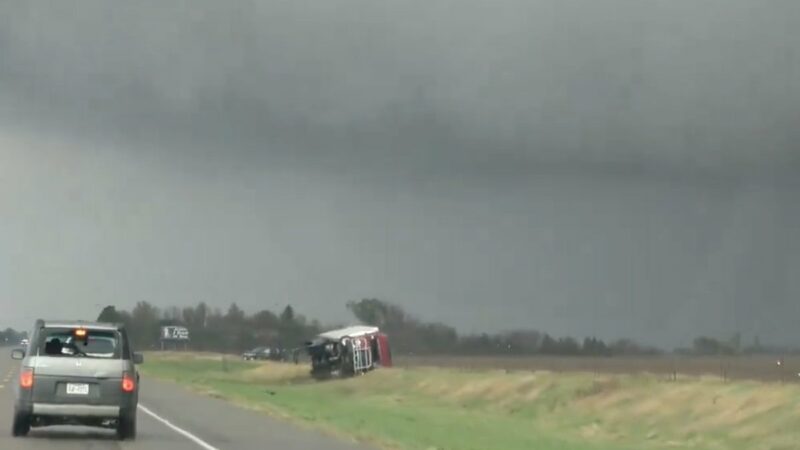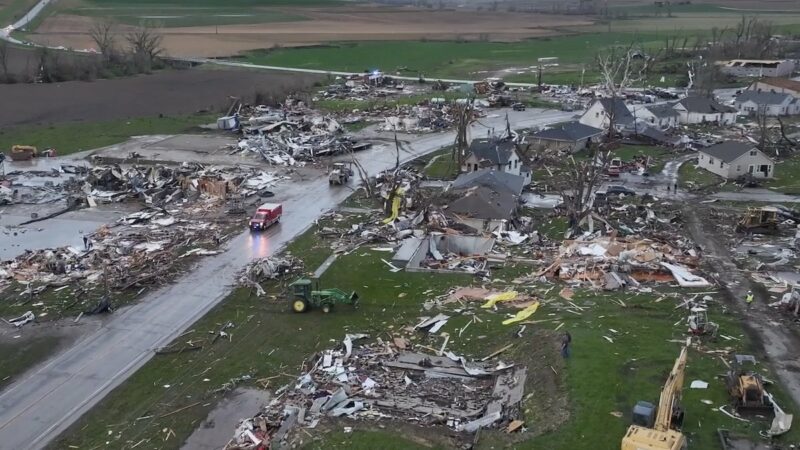The Best Camping Tents for Your Outdoor Home Away From Home
Camping is the ultimate outdoor pastime, and finding the perfect tent is the outdoorsperson’s ultimate quest—at least gear-wise. Selecting the best camping tent for your needs is perhaps the biggest decision you’ll face as you prepare to start making some core memories out in the wilderness.
Videos by Outdoors
It’s your home away from home, after all. Your tent will shelter you in the event of inclement weather, it’ll store gear, and it’ll be the perfect place to tuck in for a good night’s sleep.
You want to choose a camping tent that has enough space for you, your stuff, and however many tent mates you have along for the adventure. Besides tent capacity, you’re also likely concerned about quality, durability, ease of use and setup, and price.
You may also be concerned about packed weight, livable space, and weather protection and resistance. Don’t worry, we’ve got you. We’ve done the research and outlined the best options for camping tents that suit a variety of use cases—from ultralight tents to family tents and everything in between.
Check out our recommendations, then familiarize yourself with what you should be looking for when shopping for the perfect camping tent.
Gear is often the toughest part of camping, but it can also be one of the funniest parts. Once you’ve got the tent you need, you’re off to a fantastic start, and you’ll be out enjoying nature before you know it.
Product Reviews: Find the Right Camping Tent for You
Know what you’re looking for? Jump right to the section you need.
Our Pick for Best Ultralight Tent – ZPacks Duplex Tent
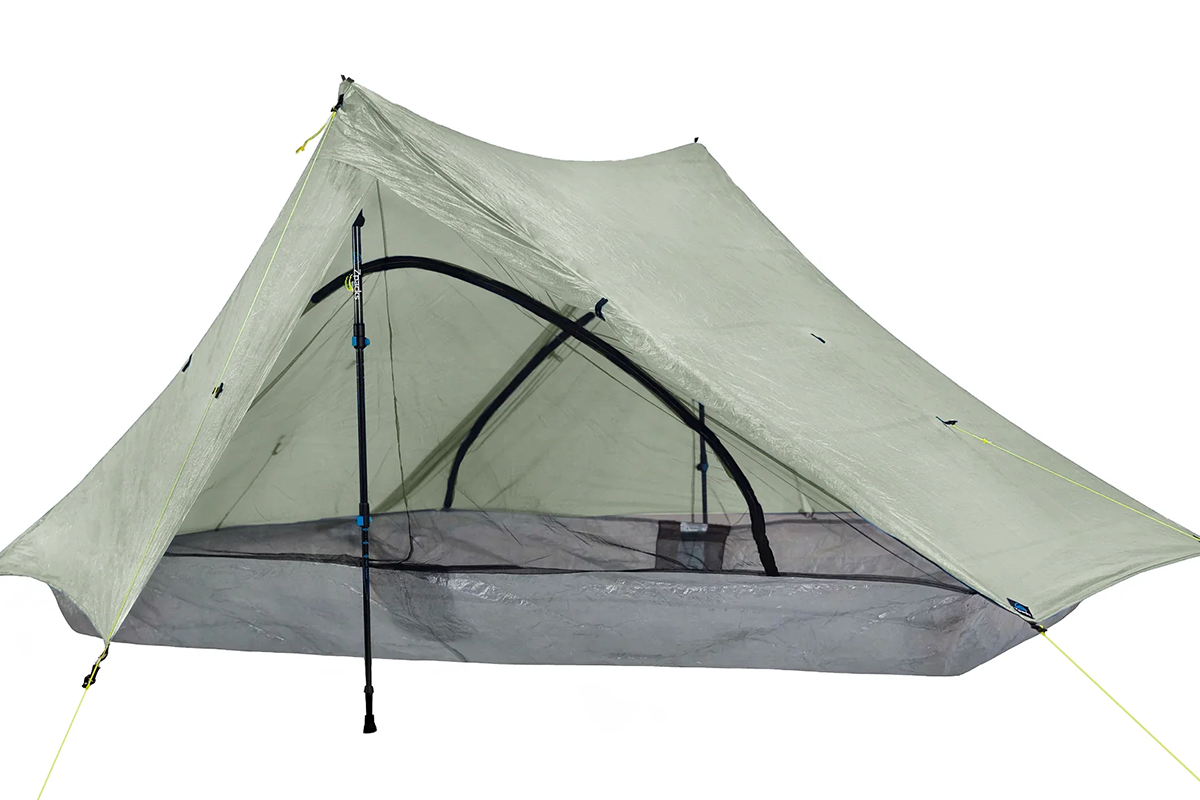
Specs:
- Weight: 18.1 oz
- Capacity: 2 person
- Floor Dimensions: 90 x 45 inches
- Seasons: 3 Seasons
At just over 18 ounces and a packed size of six by 12 inches, the ZPacks Duplex tent is a lightweight champ and our top pick in the ultralight category. If you’re doing some long-distance thru-hiking, this is an investment worth making. It’s a trekking pole tent, which helps cut down on the packed weight.
It’s durable, thanks to its Dyneema Composite Fabric, and it does not absorb a bunch of water that will add weight to your pack. There are mesh storage pockets, but in general, this camping tent keeps things simple.
Thru-hikers love this tent as is, but if you want to accessorize, you can add a groundsheet to further protect the tent floor or ultralight stakes to keep your pack as light as can be. Stakes are required but not included.
Our Pick for Best Backpacking Tent NEMO Hornet OSMO Ultralight 3P
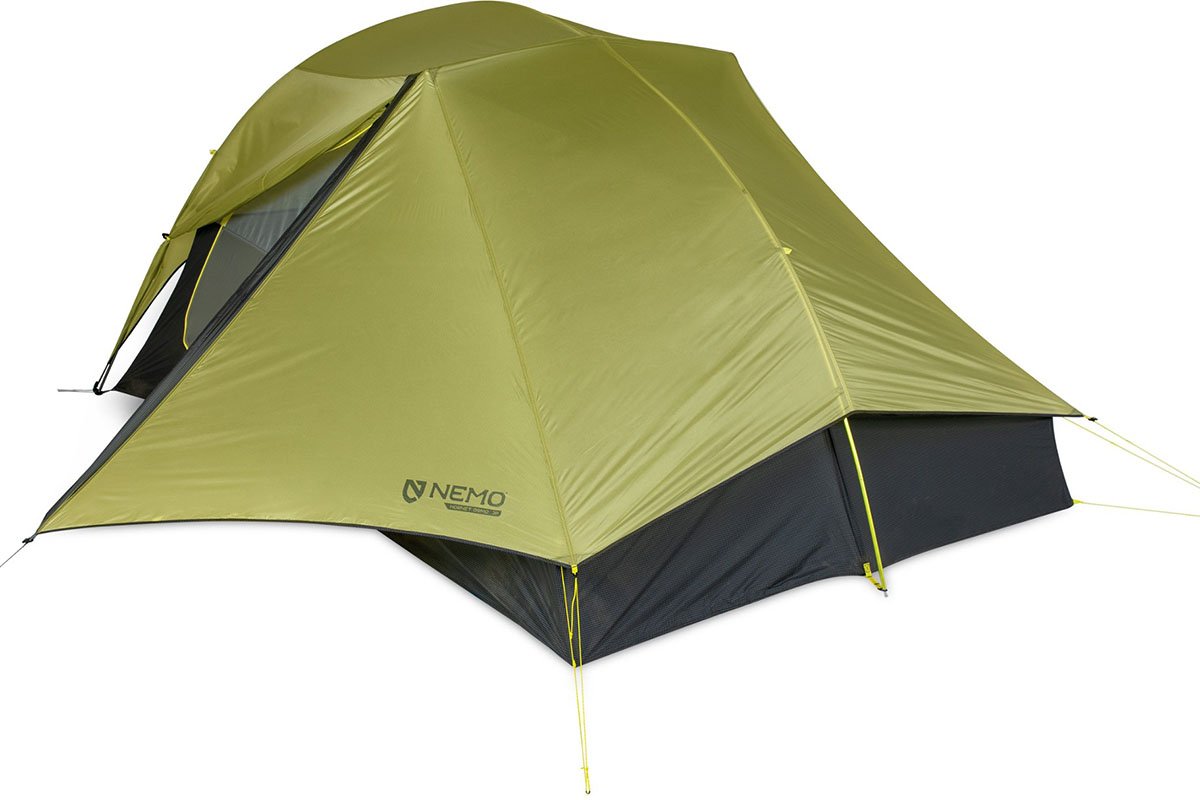
Specs:
- Weight: 2 lbs 13 oz
- Capacity: 3 people
- Floor Dimensions: 88 x 68/62 (head/foot) inches
- Seasons: 3 seasons
In the realm of backpacking tents, the NEMO Hornet OSMO series is well loved. It features NEMO’s proprietary OSMO™ polyester nylon ripstop fabric with improved water repellency and less stretch than previous models. The OSMO fabric is also sustainable and made from recycled yarns that are PFAS-free.
Owners say this tent is both lightweight and spacious, and is a solid option for backpacking trips. Set up and take down are simple with the Hornet OSMO Ultralight 3P.
The tent has two doors, privacy mesh on the side, and unique features like special interior pockets that turn a headlamp into a tent lantern by “removing blue light and casting an even glow.”
It does not come with a footprint, but it does come with a Divvy Cube™ stuff sack (the packed size is 8 x 17.5 inches), and you can split the weight with your hiking partner. NEMO also offers a two-person and one-person version of this tent, which is covered by the NEMO Lifetime Warranty.
Our Pick for Best Instant Tent – CORE 6 Person Instant Cabin Tent
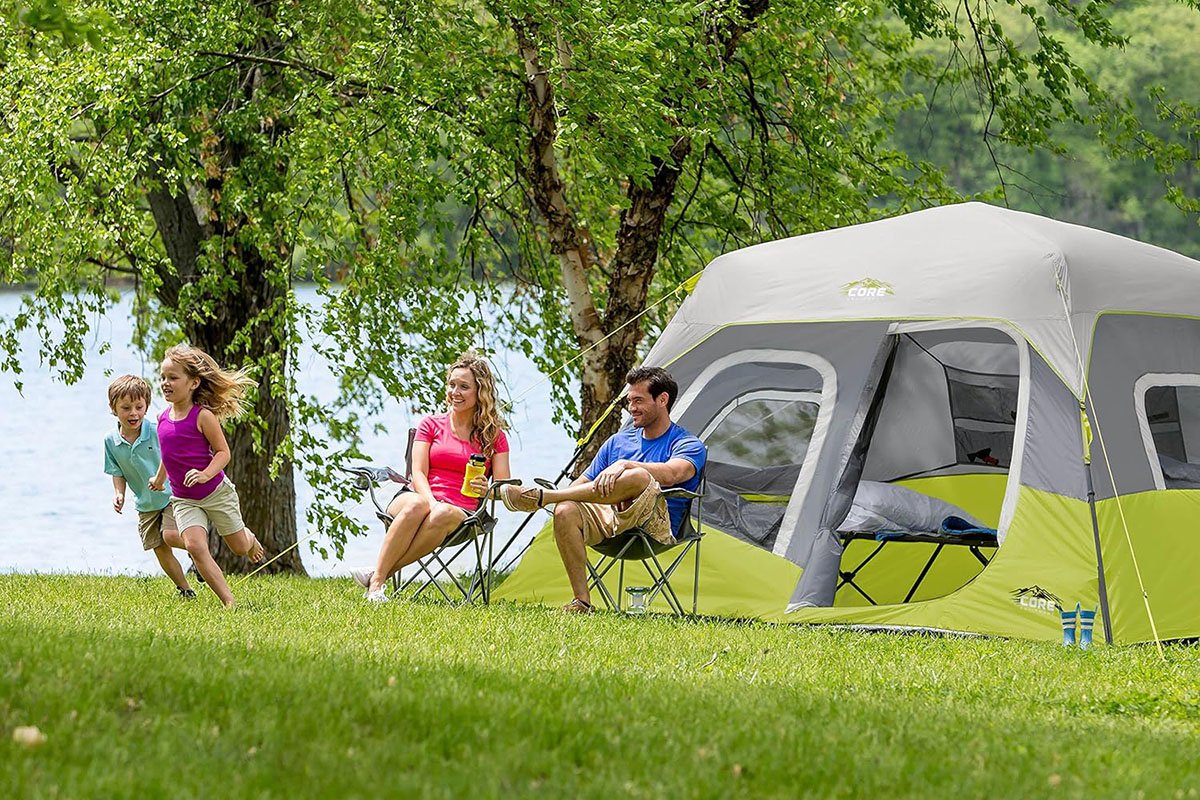
Specs:
- Weight: 23 lbs
- Capacity: 6 people
- Floor Dimensions: 132 x 108 inches
- Seasons: 3 season
If you’ve got 60 seconds, you’ve got enough time to set up camp . . . as long as you’ve got a CORE Instant Cabin tent. Unlike traditional camping tents, this one has pre-attached poles that seamlessly lock into place, which means car campers can arrive at a campsite and pitch a tent in no time.
The CORE 6 Person Instant Cabin tent is quite spacious and has a room divider, making both this and CORE’s nine-person version good options for family camping tents. It’s inexpensive, so it’s accessible to beginners who don’t want to mess with complicated setups.
Some reviewers aren’t sold on this tent’s weather resistance, so it may not be the best for camping in places where you need a lot of weather protection.
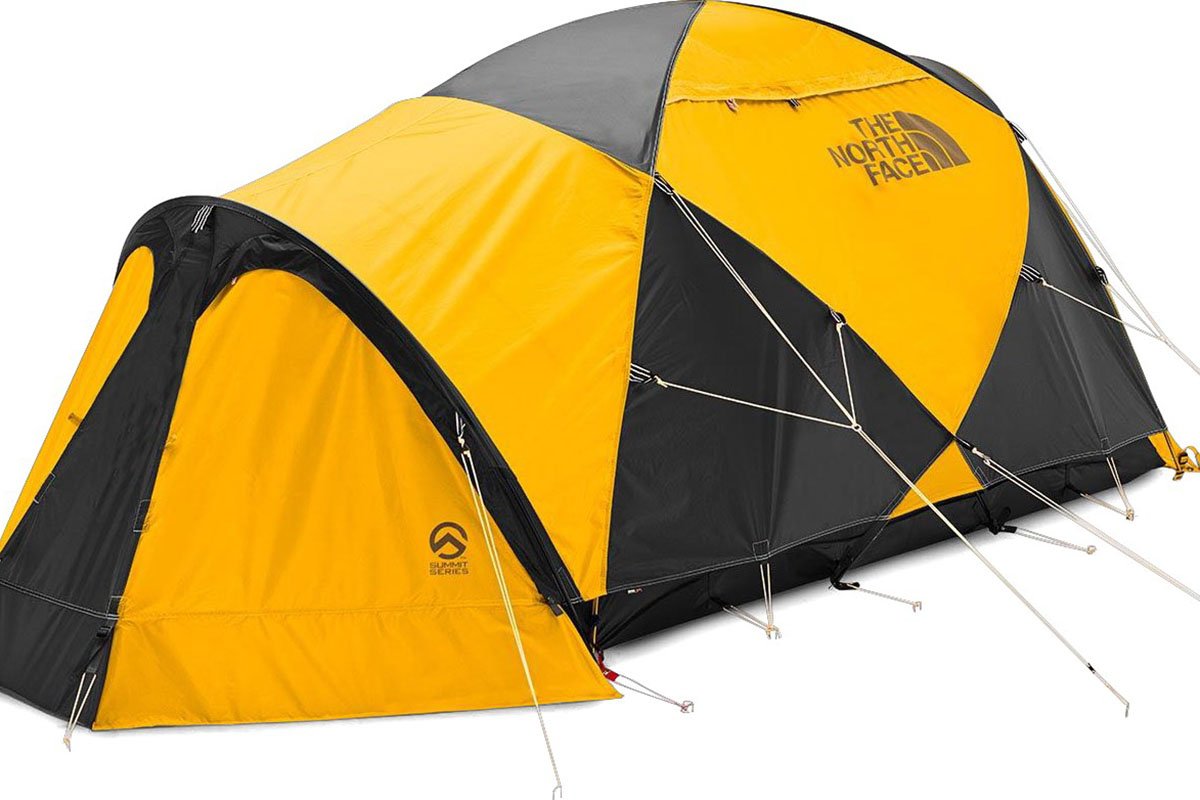
Specs:
- Weight: 8 lbs 13 oz
- Capacity: 2 person
- Floor Dimensions: 86 x 54 inches
- Seasons: 4 seasons
Four-season tents can get really expensive, and they’re typically only necessary in alpine and mountaineering situations. The North Face Mountain 25 camping tent will do its job no matter what Mother Nature throws at you and your expedition.
In case you’re ever in extreme cold conditions, this four-season tent has a port window that’s cold-crack tested to -60°F (-51°C). It has a fully taped bucket tent floor, high-strength reflective guy lines, and glow-in-the-dark zipper pulls.
The North Face includes snow stakes and a footprint with its Mountain 25 tent.
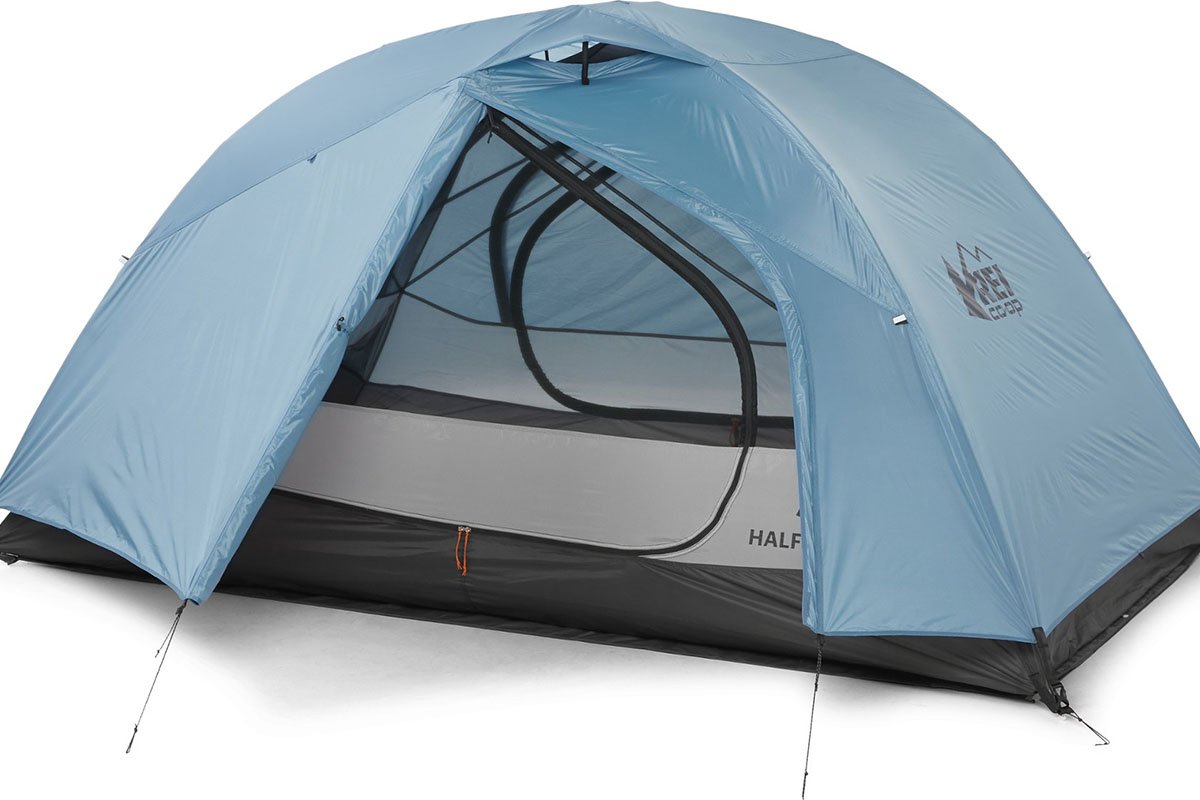
Specs:
- Weight 3 lbs 15 oz
- Capacity: 2 people
- Floor Dimensions: 90 x 54 inches
- Seasons: 3 season
REI’s beloved Half Dome tent is a solid choice for a no-nonsense tent that gets the job done. At a good price, the Half Dome SL 2+ Tent offers room for two people and gear, and it comes equipped with a rain fly, a footprint, guy lines with tighteners, a pole-repair tube, a pole bag, eight stakes, and a stake bag.
Thanks to Superlight (SL) construction, this Half Dome model is quite light, but it doesn’t skimp on features like nearly vertical walls for headroom, large D-shape doors, and two dual-stake vestibules for some extra covered storage space. Customers note this tent isn’t a top choice in the heavy rain.
Our Pick for Best 3-Person Tent – Mountain Hardwear Mineral King 3 Tent
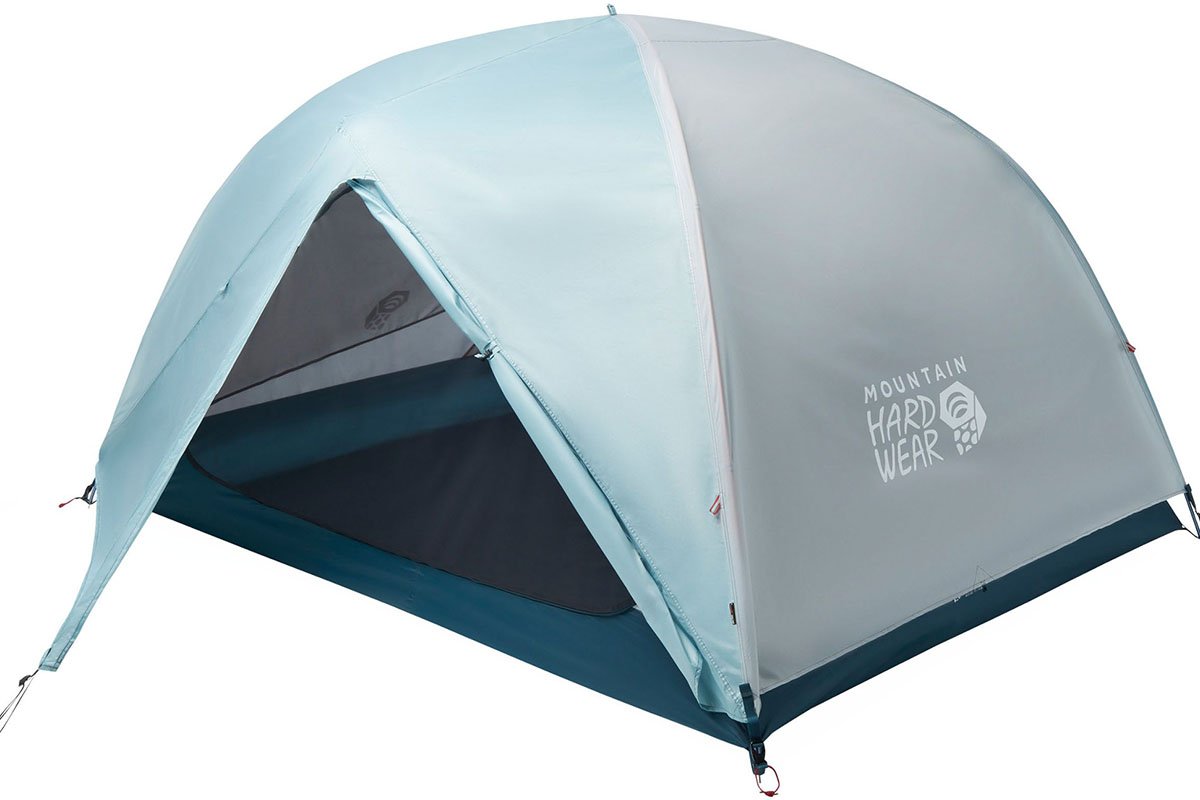
Specs:
- Weight: 6 lbs 1.7 oz
- Capacity: 3 people
- Floor Dimensions: 90 x 68 inches
- Seasons: 3 season
The Mountain Hardwear Mineral King 3 Tent is designed to hold three people, but is great for two people and some extra room. Mountain Hardwear is a trusted brand.
The Mineral King 3 has features, like large doors, dry-entry vestibules, interior storage, seam taping, and an included footprint to extend the life of the tent floor. This tent is a good option for car camping but is likely too heavy for backpacking. Reviewers note that the instructions could be better.
Our Pick for Best 4-Person Tent: Snow Peak Alpha Breeze Tent
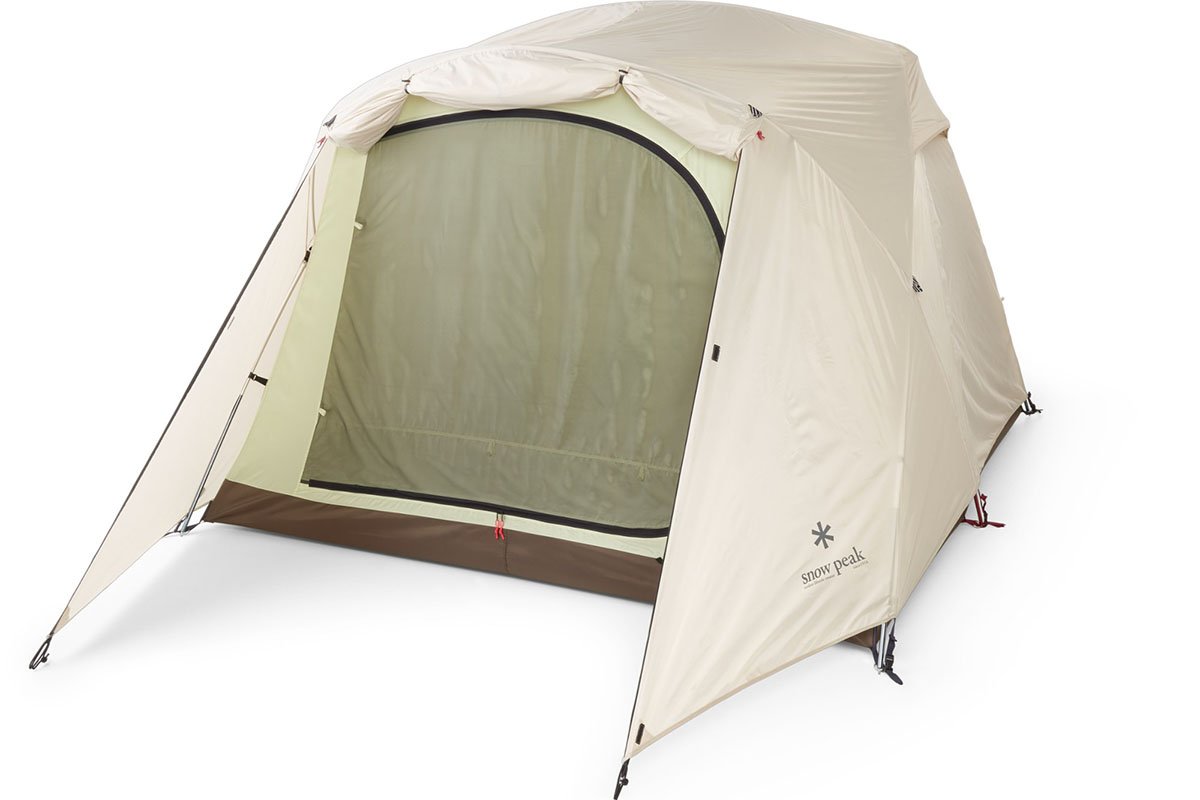
Specs:
- Weight: 24 lbs 3.2 oz
- Capacity: 4 person
- Floor Dimension: 109 x 102 inches
- Seasons: 3 season
If you’re a family of four, the Snow Peak Alpha Breeze is a top pick for your next camping tent. The number of doors and windows on this thing alone makes it stand out in the field (there are four windows and four doors).
Reviewers rave about its many excellent qualities, like how it stands up to weather, is roomy, and is quick to set up and take down. There’s also an extendable vestibule flap that provides shade or extra living space.
The Alpha Breeze is stylish, too, with its design inspired by Adirondack cabins. If you’re car camping and weight isn’t an issue, definitely take a look at this one.
Our Pick for Best 6-Person Tent – COLEMAN Evanston Screened 6 Person Tent
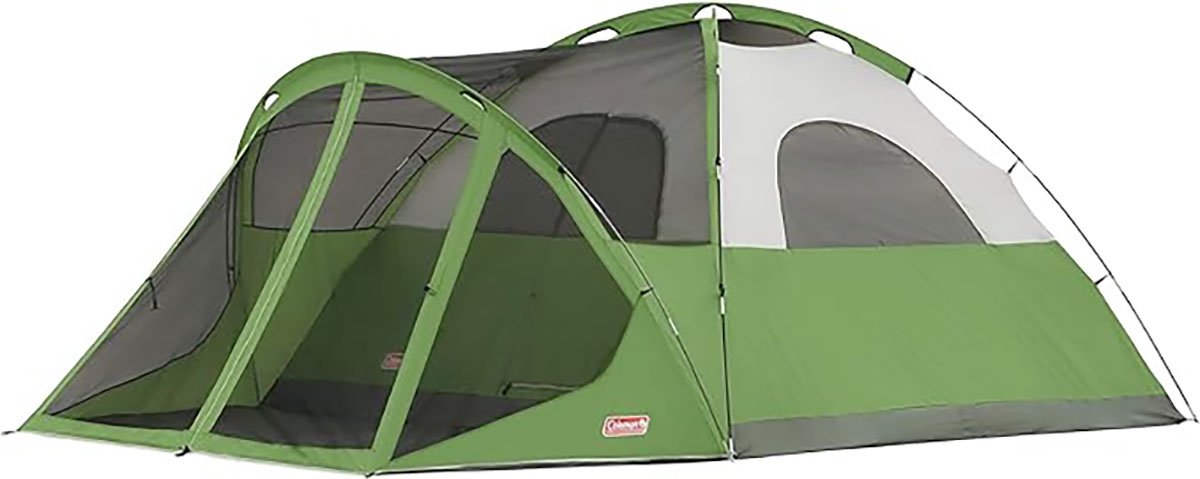
Specs:
- Weight: 20.9 lbs
- Capacity: 6 people
- Floor Dimensions: 168 x 108 inches (not including screened porch area)
- Seasons: 3 season
COLEMAN’s Evanston screened dome tent is one of those iconic car-camping tents you see around campsites, and it’s easy to see why. It’s affordable, and it’s big enough for families. (It can even fit two queen-sized air mattresses side by side.)
It features a bug-free screened porch and the fact that the Evanston is made by COLEMAN, which makes time-tested camping tents. There are the less-obvious perks, as well, like window awnings and COLEMAN’s WeatherTec system that’ll keep you dry and withstand 35+ MPH winds.
With over 8,000 reviews on Amazon and an overall 4.6-star rating, this is a go-to family-sized tent that’s definitely worth consideration.
Our Pick for Best 8-Person Tent – The North Face Wawona 8 Tent
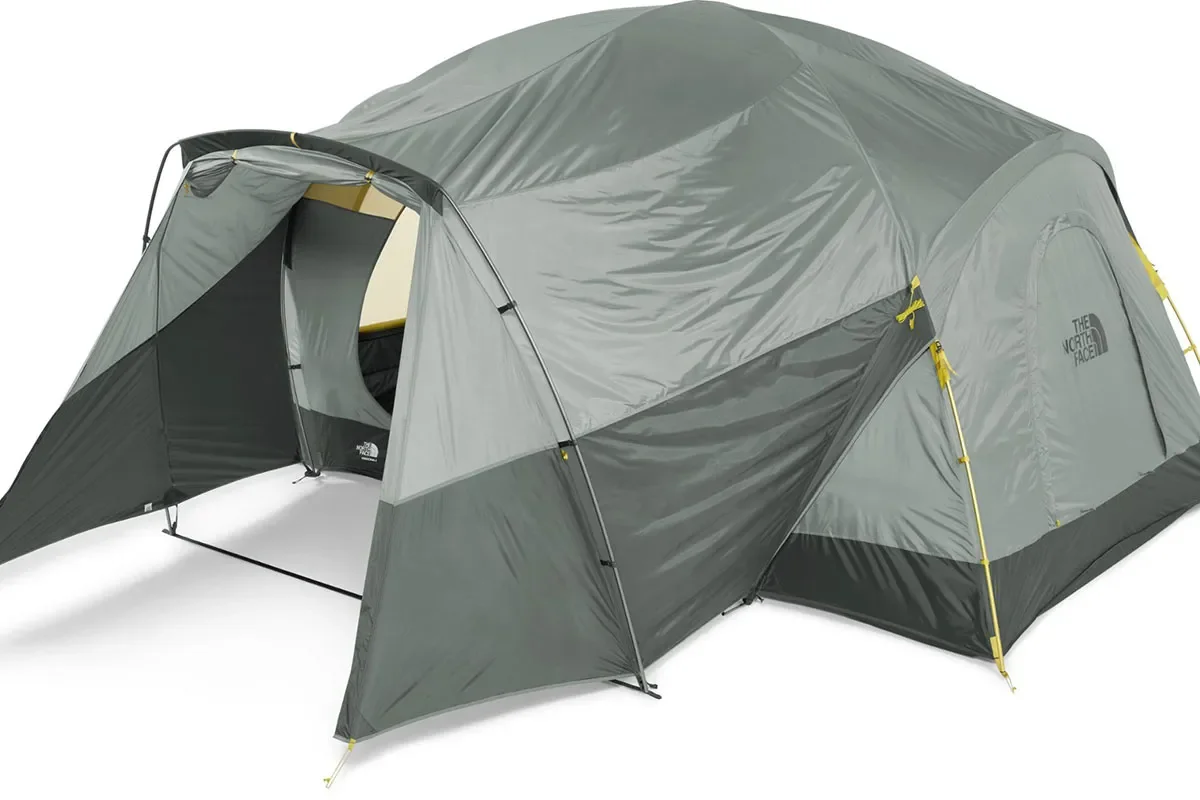
Specs:
- Weight: 18 lbs 1.2 oz
- Capacity: 8 people
- Floor Dimensions: 168 x 96 inches
- Seasons: 3 season
If you need to sleep more than six people or want a separate sleep and living space inside the tent, look no further than The North Face Wawona 8. This tent has near-vertical walls for extra standing room, three doors for easy entry, a room divider, a tent-wide window, and a bonus vestibule area outside.
It’s light for as big as it is, but at 18 pounds, it’s suited for car camping and not hike-in campsites. You get The North Face quality and attention to detail. Reviewers say the Wawona 8 is a true home away from home, with way more space than other tents.
Our Pick for Best Budget Tent – ALPS MOUNTAINEERING Meramac 2
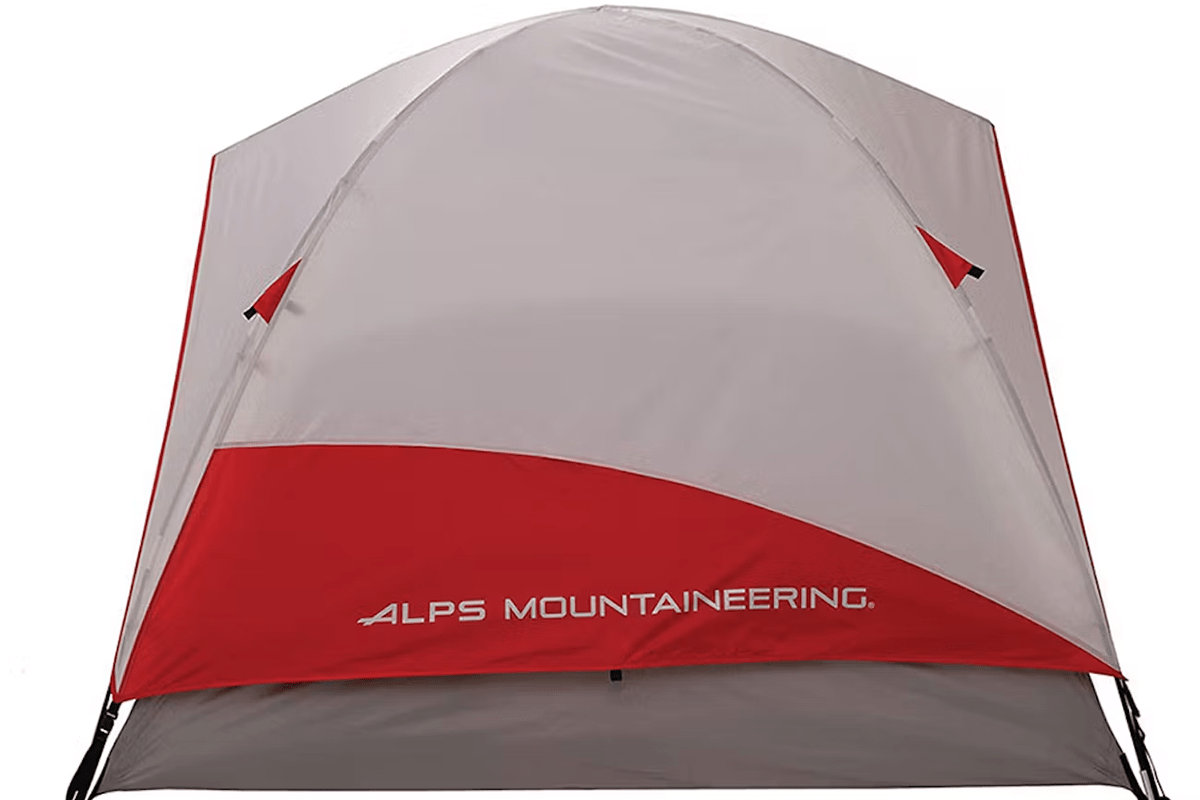
Specs:
- Weight: 7 lbs 9 oz
- Capacity: 2 people
- Floor Dimensions: 90 x 60 inches
- Seasons: 3 season
If you don’t have hundreds of dollars to spend on other tents, don’t worry. When it comes to budget tents, the ALPS MOUNTAINEERING Meramac 2 covers all your bases for under $100. This tent is a free-standing, dome-shaped tent with two doors and fiberglass poles, and an awning over each door.
The ALPS MOUNTAINEERING Meramac 2 is inexpensive, but it’s not too small, and it’s not too heavy. It doesn’t come with a footprint or a stuff sack, but you can add on those accessories as budget allows.
Our Pick for Best Tent for Expeditions – Mountain Hardwear Stronghold Tent: 10-Person 4-Season
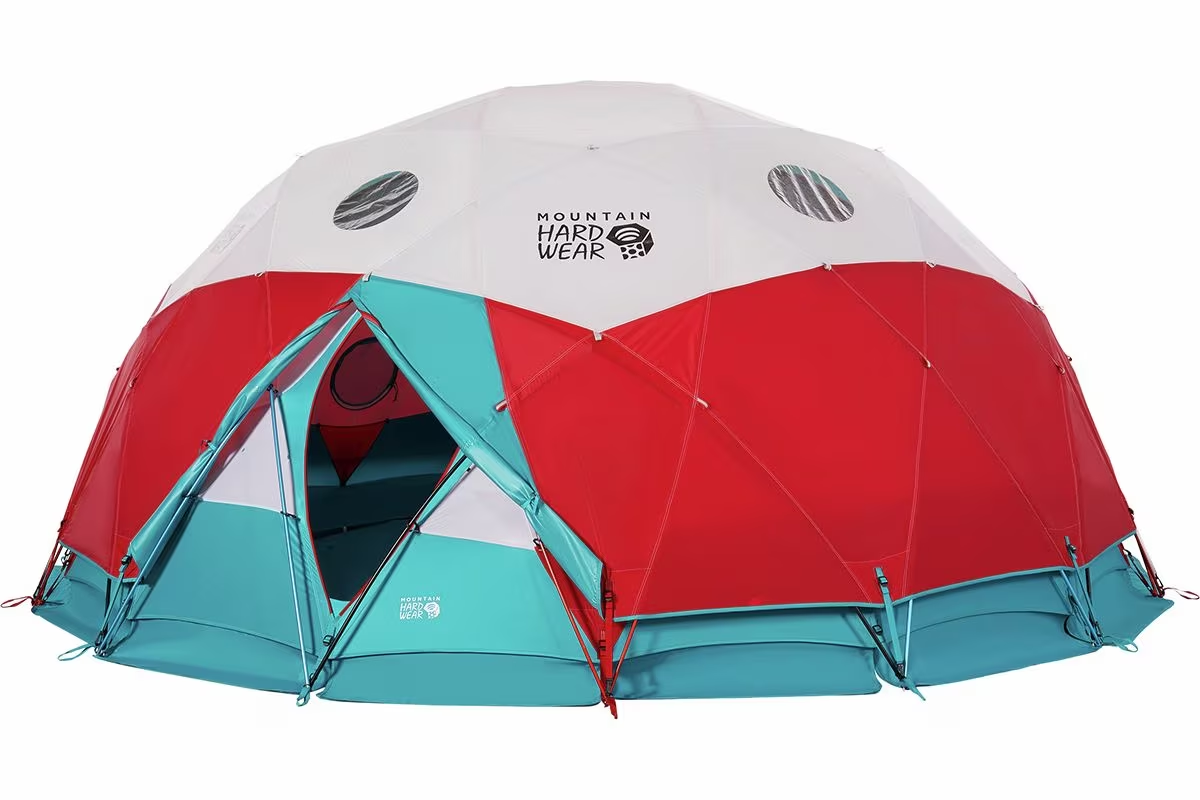
Specs:
- Weight: 41 lbs 2 oz
- Capacity: 10 people
- Floor Dimensions: 177 in (only one-floor dimension available from the manufacturer)
- Seasons: 4 season
If you’re going on an expedition, don’t mess around when selecting your tent. Choose a four-season tent that’ll hold your team, your gear, and more—like the Mountain Hardwear Stronghold Tent. The Stronghold features snow flaps. Its dome shape sheds wind and snow, and it has five UVX windows.
The Stronghold will support your most intense adventures. It also doesn’t skimp on the traditional tent features like vents, pockets for storage, and color-coded parts for relatively easy set up.
When your shelter is essential for your mission—or maybe even your survival—the Mountain Hardwear Stronghold won’t let you down.

Buyers Guide: How to Select the Best Camping Tent
Not sure where to even start when shopping for a tent? Don’t worry, we’ve got you. Begin with these basics: capacity, quality, portability, ease of use, and price. We break down each one below.
Capacity
Here’s the thing about tent capacity—you can’t trust it. Tent capacity tells you how many people can sleep side-by-side in sleeping bags on the floor of the tent like sardines. If this is how you prefer to sleep, like sardines, then okay, you can trust it. If not, take “capacity” with a grain of salt.
When selecting a camping tent, consider your group size and space needs, then check the capacity listed by the manufacturer as well as the interior space measurements.
It’s wise to assess not only the square feet of floor space available but also the height of the interior space, which will give you a sense of the available standing room. Most people also prefer to have some livable space for changing, playing games, or hanging out if the weather is not ideal.
Unless you’re backpacking or have little to no gear with you, it’s nice to have some floor space inside your tent to keep your belongings, so consider counting your stuff as a “person” when evaluating tent capacity.
The bottomline when it comes to capacity and interior space: When in doubt, size up. If you need to pack light but want to make a smaller tent more livable, consider adding vestibule space—a covered area outside the tent door.
Quality
Selecting a quality tent is going to serve you for the long run (just ask anyone who has experienced a leaking tent.) If you’re able to inspect the tent body in person before purchasing, check the construction and materials for quality by looking at the fabrics, zippers, and stitching.
Check the accessories, too, including the tent poles, stakes, and rain fly.
Whether you can inspect a tent in person or not, read reviews from other users online before purchasing. Pay particular attention to reviews that talk about long-term durability versus offering first impressions.
Make sure to consider its weather resistance. Most tents offer plenty of ventilation, which keeps moisture from building up inside of the tent body, and they typically come with a rain fly to keep rain out. Choose a tent with sturdy guy lines and tie-out points to keep it from blowing away in the wind.
Portability
Camping tents can be heavy, but they can also be super light, depending on your needs. Remember as you assess capacity and quality that you’re going to have to transport this thing, so consider the tent’s packed size and weight. Do future you a solid and choose something that’s reasonably portable.
The type of camping you plan to do will dictate how important portability is. For instance, if you’re thru-hiking in the backcountry, you may opt for a lighter tent over a heavier and more spacious tent. If you’re car camping, portability matters much less. Most use cases fall somewhere in between.
Ease of Use
On a scale from 1 to 10, how handy are you? If you’re on the low end of this scale, consider an instant or pop-up tent design to make the setup process quick and easy.
A more standard camping tent requires using tent poles and clips to support the tent body. Check reviews online for the tent you’re considering. Many reviewers will mention ease of setup.
Beyond ease of setup, your tent should be easy to use after it’s up. Did you select something with a spacious interior that lacks storage pockets? That won’t do.
Also consider the number of doors. If you have a family tent with only one door, is that going to cut it for your group? Two doors may work better. Pay attention to the size of the tent doors, too. If you’ve selected a huge tent to accommodate tall campers, you’ll want large doors too.
Price
There are solid camping tents on both ends of the price spectrum. An inexpensive tent may lack in quality what pricier tents offer, but you can find plenty of good-quality tents at a very reasonable price tag. Consider what you’re willing to spend, and then find the best bang for your camping-tent buck.
Camping Tent FAQs
What’s the difference between a three-season and four-season tent?
A three-season tent works well for spring, summer, and fall. For these three seasons, ventilation is important to keep tents from becoming too stuffy and uncomfortably warm inside. Three-season tents offer mesh panels and lightweight, breathable materials.
Compared to four-season tents, they tend to weigh less and may not hold up as well against heavy rain or wind. A three-season tent may not be the best choice if you do a lot of winter camping (especially if you’re camping in places with harsh winters).
Alternatively, a four-season tent is designed to withstand winter weather, including freezing temperatures, strong wind, rain, and snowfall. These tents hold in heat and keep the wind and weather out.
The downside to buying a four-season tent is that it will inevitably be heavier and probably also more expensive than a three-season tent. However, if you’re mountaineering or camping in places with extreme conditions, you should invest in a four-season tent to stay as comfortable as possible.
What are the different types of tent poles?
Aluminum tent poles are the most common, because aluminum is both lightweight and strong. However, as you shop for a tent, you may see other options.
Fiberglass poles are a popular alternative to aluminum poles for budget options where weight is less of a factor. On the other end of the spectrum, carbon fiber poles are lightweight and strong, but they are on the more expensive side.
For ultralight tents, you may come across a pole-less option, which requires using trekking poles instead of traditional tent poles to prop up the tent.
What shapes of tents are available?
Dome-style tents are common and popular, because they maximize headroom and space inside while also often offering the benefits of being lightweight and easy to set up. Compared to dome tents, a traditional A-frame tent lacks standing room anywhere but the middle of the tent.
Cabin-style tents are typically tall, spacious, and have multiple rooms inside. Tunnel tents are elongated and rounded, often also forming multiple “rooms.” Geodesic tents are dome-like but have a more complicated pole and support structure, which makes them ideal in harsh weather.
If you’re looking to get off the ground for your next camping excursion, you can pick up a roof-top tent, which connects to your vehicle and offer a covered sleeping space above the cabin of your car or the bed of your truck.
Many tents come with a footprint, which provides extra protection for the tent floor. While not always necessary, it is best practice to use a footprint to prolong the life of your camping tent.
Check the packaging information about if the tent you’re purchasing comes with a footprint, or if you’ll need to buy one separately.
What is a tent vestibule?
A tent vestibule is a covered area outside a tent that, depending on the type, position, and size, may offer shade for seating, a covered storage space for gear, and/or a covered space for putting shoes on or taking them off before entering your tent.
Tent vestibules may be attached to the front of a tent above the door or swing out to the side. Often, vestibules serve as a sort of mudroom to help you transition from outside the tent to inside without bringing dirt, mud, or rain along with you.
Ready to Find the Best Camping Tent for You?
Now that you know what to look for in a tent, you’ve read through some frequently asked questions, and you’ve perused our picks for best camping tents in various categories, you’re heading in the right direction.
Your budget, specific wants and needs, and group size will help you narrow down the seemingly infinite choices.
Ask yourself how much room you want and need, how light your gear has to be, how hot or cold the weather will be where you’re camping, and what extras are most important to you. Once you figure all of this out, it’s a matter of selecting the highest-quality tent within your budget that meets your criteria.
A tent is a key piece of camping gear, and you shouldn’t take the decision lightly. Choose something durable, and it’s likely the only tent you’ll need to buy this decade.
Source: https://outdoors.com/best-camping-tents-for-your-outdoor-home/

